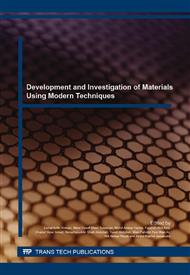p.180
p.185
p.191
p.197
p.202
p.207
p.213
p.220
p.225
Effect of Using Different Compositions and PU Foam Template to Produce Cobalt Chromium Molybdenum (CoCrMo) Foams
Abstract:
Slurry dipping is a simple and popular method of producing porous and interconnected foams using a metallic slurry. The advantage of the network-like metal foams is it exhibits a natural bone-like structure which enables ingrowth of bone cells and blood vessels. The aim of the present study was to investigate the effect of using difference composition and scaffold to produce Cobalt Chromium Molybdenum (CoCrMo) foams. The CoCrMo slurry was prepared by using different composition of CoCrMo powder which was 60wt%, 65wt% and 70wt%. Also two different types of scaffold were used in this study. The CoCrMo slurry was produced by mixing CoCrMo powder with Polyethylene Glycol (PEG), Carboxyl Methyl Cellulose (CMC) and distilled water. Then, polyurathane foam template was dipped in CoCrMo slurry and dried at room temperature. Sintering process was running by vacuum furnace at high temperature, 1200°C. The CoCrMo foam was characterized by using a Scanning Electron Microscopy (SEM) analysis. The physical properties of CoCrMo foam was analyzed by porosity and bulk density test that was Archimedes method. From the study it was expected that the composition of metallic slurry play important roles to produce a CoCrMo foam. In order to orthopaedics application to apply in cancellous bone, highest value of porosity from PU foams type (a) was most suitable result to use. This is due to the value of porosity that generate that was 65.2%.
Info:
Periodical:
Pages:
202-206
Citation:
Online since:
January 2016
Authors:
Keywords:
Price:
Сopyright:
© 2016 Trans Tech Publications Ltd. All Rights Reserved
Share:
Citation:


